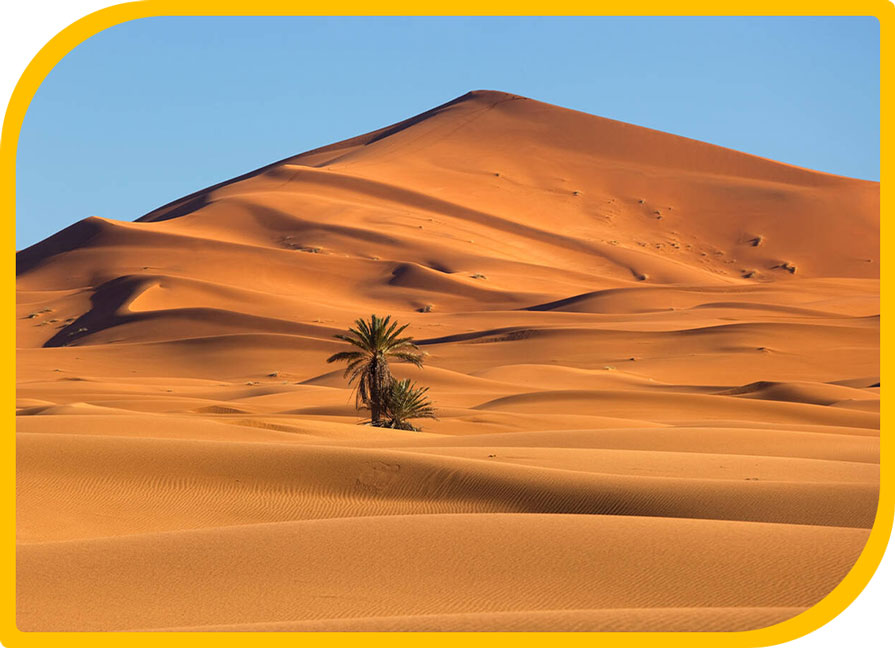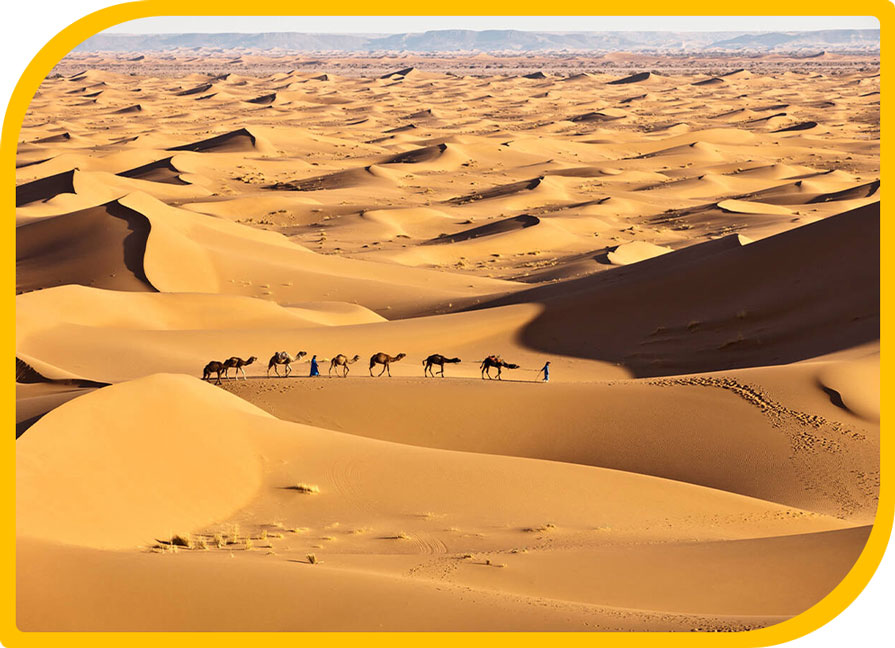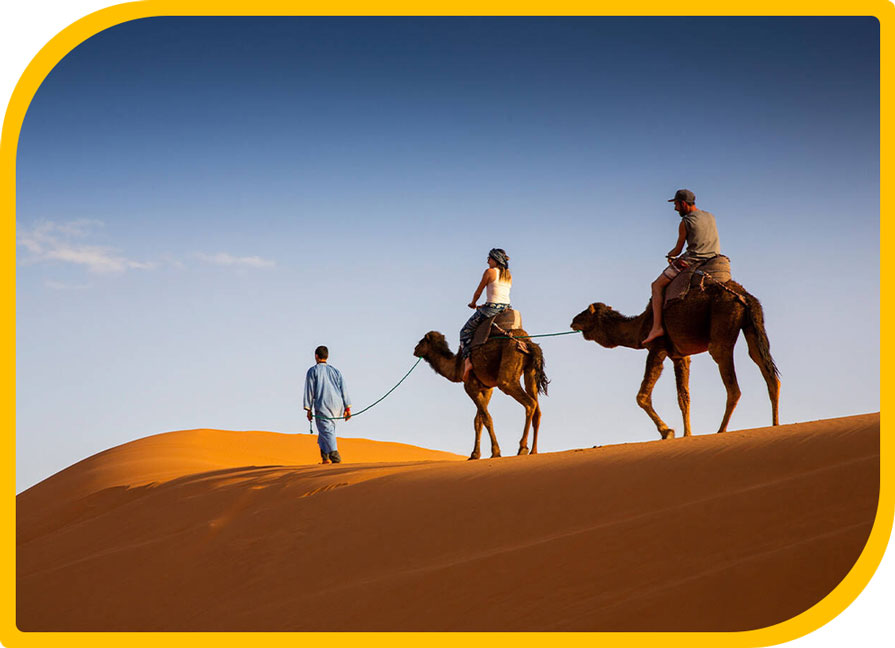Riding Camels in the Sahara: Everything You Need to Know
The Sahara Desert is one of the world’s most iconic natural wonders, stretching across multiple countries and offering an experience that feels both timeless and otherworldly. For travelers visiting Morocco, riding camels across the golden dunes of the Sahara is often the highlight of their trip—a unique adventure that connects you to ancient traditions and breathtaking landscapes.
This guide will walk you through everything you need to know about riding camels in the Sahara, focusing on two of Morocco’s most famous dune regions: Erg Chebbi and Erg Chigaga. You’ll learn the differences between these two spectacular locations, the pros and cons of traveling by camel versus 4×4, important safety considerations, and the variety of camps you can stay in—from luxury setups with all the comforts to budget-friendly options that still deliver an authentic desert experience.
Whether you’re planning your first camel trek or just want to make sure you’re well-prepared for your Sahara adventure, this detailed guide has you covered.
Understanding the Sahara: Erg Chebbi vs Erg Chigaga
When planning your camel ride in the Sahara, one of the first big decisions is choosing where you want to explore. Morocco’s Sahara features two main dune areas popular with travelers: Erg Chebbi and Erg Chigaga. Each offers a very different experience, so it’s worth understanding their unique characteristics.
What Are Erg Chebbi and Erg Chigaga?
- Erg Chebbi:
Erg Chebbi is the more famous and accessible of the two. Located near the town of Merzouga, this dune field covers about 22 kilometers and features dunes that can reach up to 150-200 meters in height. The landscape is characterized by golden sand that seems to glow at sunrise and sunset, making it a favorite for photographers and first-time visitors. Because it’s easier to reach, Erg Chebbi attracts more tourists and has more developed infrastructure, including many campsites and tour operators.

- Erg Chigaga:
Erg Chigaga is much larger and wilder than Erg Chebbi, covering over 35 kilometers of dunes. Located farther south near M’Hamid, it’s more remote and less frequented by tourists, which means it offers a more untouched and solitary desert experience. The dunes here are larger and the landscape more rugged, surrounded by rocky plateaus and dry riverbeds. Because of its remoteness, getting to Erg Chigaga often requires a longer 4×4 journey or a more intense camel trek.

Location and How to Get There
- Erg Chebbi:
Situated about 50 km southeast of Erfoud and easily reachable from Merzouga, Erg Chebbi can be accessed by car or public transport with relative ease. Many tour operators run camel treks and 4×4 tours starting from Merzouga, making it a convenient choice for travelers with limited time. - Erg Chigaga:
Erg Chigaga lies approximately 70 km southwest of M’Hamid, a small desert village. Reaching Erg Chigaga requires a longer and often bumpier 4×4 ride across rocky desert terrain. Due to this, tours here are generally more adventurous and less commercialized. Some travelers also choose to start multi-day camel treks from M’Hamid into the heart of the dunes.
Experience Differences
- Tourist Density:
Erg Chebbi tends to be busier, especially during peak seasons, with more tourists, larger camel caravans, and more developed camps. Erg Chigaga offers a quieter, more remote atmosphere ideal for travelers seeking solitude and a deeper connection with nature. - Atmosphere and Scenery:
Erg Chebbi’s dunes have a smoother, golden appearance with vast open spaces ideal for sunrise and sunset photography. Erg Chigaga’s dunes are more rugged and can feel wilder, surrounded by rocky plateaus and offering more challenging terrain for trekking.
Which One Is Right For You?
- Choose Erg Chebbi if you want easier access, a variety of camp options (including luxury camps), and a classic Sahara experience with amenities close by. It’s perfect for first-timers or those with limited time.
- Choose Erg Chigaga if you crave adventure, solitude, and a raw, less touristy desert experience. Ideal if you want to combine camel trekking with off-the-beaten-path exploration and don’t mind a longer journey to get there.
Ready to Ride into the Sahara?
Don’t just dream about the golden dunes—experience them! Whether you choose the towering sands of Erg Chebbi or the wild beauty of Erg Chigaga, riding a camel into the heart of the desert is a once-in-a-lifetime adventure.
Pick your dunes
Plan your route (camel, 4×4, or both!)
Pack smart for the desert day and night
The Sahara is waiting—start planning your unforgettable journey today!
Riding Camels in the Sahara vs 4×4 Tours: Pros and Cons
When it comes to exploring the Sahara Desert, you have two main transportation options: traveling by camel or by 4×4 vehicle. Both offer unique ways to experience the desert, and your choice will shape your adventure. Let’s break down the advantages and drawbacks of each.
Camel Trekking
Pros:
- Authentic Experience: Riding a camel through the desert is a timeless way to connect with the Sahara’s heritage. Camels have been the traditional mode of transport for centuries, and traveling on their backs immerses you fully in the desert environment.
- Slower Pace: Traveling by camel means you move at a gentle, steady pace, allowing you to appreciate the vastness, silence, and subtle beauty of the dunes. This slower pace is perfect for reflection, photography, and connecting with your surroundings.
- Access to Remote Areas: Camels can navigate terrains that vehicles might struggle with, especially narrow paths or soft sand where 4x4s risk getting stuck.
Cons:
- Physical Demands: Riding a camel requires some endurance and balance. The gait of a camel is a slow rocking motion, which can be uncomfortable or tiring for some, especially over several hours.
- Limited Speed and Distance: Because camels move slowly, you won’t cover large distances in a short time. This might be a downside if you’re short on time.
- Less Comfort: Camels don’t offer cushioned seats like a vehicle, so expect a more rugged, less cushy ride.

4×4 Tours
Pros:
- Speed and Efficiency: 4×4 vehicles allow you to cover much more ground in a shorter period, making it ideal if you want to explore more of the desert or combine stops.
- Comfort and Convenience: Modern 4x4s are equipped with suspension and seating that make the ride smoother and less physically demanding than riding a camel.
- Access to Remote and Rugged Areas: Some parts of the desert are hard to reach on foot or camel, and 4x4s can navigate rocky plateaus and longer desert routes quickly.
Cons:
- Less Authentic: While efficient, riding in a vehicle doesn’t have the traditional feel and connection that camel trekking offers.
- Noise and Environmental Impact: Vehicles generate noise and emissions, which can disrupt the natural tranquility of the desert.
- Risk of Getting Stuck: Though less common with experienced drivers, 4x4s can get stuck in deep sand or rocky terrain.

Combining Both: Is It Possible?
Many tours offer combined experiences—riding camels into the dunes and returning by 4×4, or vice versa. This can be a good way to enjoy both worlds: the authentic camel trek experience and the speed and comfort of a vehicle.
Choosing Based on Your Travel Style
- Opt for camel trekking if you want a deeply traditional, immersive experience and don’t mind a slower, physically active journey.
- Choose a 4×4 tour if comfort, speed, and covering more ground are your priorities.
- If unsure, consider a combo tour to get the best of both.
Safety Tips for Your Sahara Adventure
Exploring the Sahara Desert is thrilling, but it’s essential to prepare properly to ensure your trip is safe and enjoyable. Here are key safety tips to keep in mind before and during your camel ride or 4×4 tour.
Preparing for Desert Conditions
- Clothing: Wear loose, lightweight, breathable fabrics that cover your skin to protect against sunburn and sand. Long sleeves and pants are ideal. Bring a wide-brimmed hat or a scarf (like a traditional Moroccan cheche) to shield your head and neck from the sun and blowing sand.
- Footwear: Closed, sturdy shoes or boots are best to protect your feet from hot sand and rocky terrain. Avoid sandals during long treks.
- Sun Protection: Apply a high-SPF sunscreen regularly, even if it doesn’t feel too hot. UV rays are strong in the desert. Sunglasses with UV protection are essential to shield your eyes from glare and sand.
- Hydration: The Sahara is extremely dry and hot during the day, so drink plenty of water before and during your trip. Carry a refillable water bottle and drink small amounts frequently to avoid dehydration.
Camel Safety
- Mounting and Dismounting: Camels kneel to allow riders on and off. Follow your guide’s instructions carefully. It’s normal to feel unsteady at first.
- Handling the Animal: Camels are generally docile but can be unpredictable if startled. Stay calm, avoid sudden movements, and listen to your guide. Never try to touch or feed the camel without permission.
- Balance: Sit upright and relaxed, keeping your weight centered. Hold onto the saddle handle or ropes provided to maintain stability.
Desert Navigation and Guide Importance
- Use a Professional Guide: Never venture into the desert alone. Local guides are experienced in navigating the terrain and understanding weather changes. They also handle emergencies and communicate with camp staff.
- Stay With Your Group: Always stay close to your group or guide to avoid getting lost. The desert landscape can look very similar in all directions.
Health Precautions
- Motion Sickness: Some people feel nauseous while riding camels due to the rocking motion. If prone to motion sickness, consider medication before your trek.
- Allergies: If you have allergies to animal dander or dust, bring any necessary medications.
- Emergency Contacts: Make sure your tour operator has a plan for emergencies and check that mobile phone coverage or satellite communication is available where you’ll be traveling.
Weather Considerations
- Best Time to Visit: The Sahara is best visited during the cooler months—October to April. Summers can be dangerously hot, with daytime temperatures soaring above 45°C (113°F).
- Night Temperatures: Desert nights can be very cold, sometimes dropping close to freezing. Bring warm layers if you plan to camp overnight.
Camps in the Sahara: Luxury vs Budget Options
Spending a night in the Sahara Desert is an unforgettable experience, but choosing the right camp can make all the difference. From lavish luxury camps with all the modern comforts to simple budget-friendly tents, here’s what you need to know to pick the best option for your stay.
Types of Camps
- Luxury Desert Camps:
These camps offer high-end amenities designed to provide comfort amid the wilderness. You can expect spacious, well-furnished tents or cabins with real beds, clean linens, private bathrooms (sometimes with hot water), and electricity. Luxury camps often feature cozy lounges, gourmet meals, traditional Moroccan entertainment like live music or storytelling, and attentive service. They’re perfect if you want to experience the desert without sacrificing comfort. Many also follow sustainable tourism principles promoted by UNESCO, aiming to protect the fragile desert environment while benefiting local communities. - Budget Camps:
Budget camps tend to offer more basic accommodations—usually simple tents with mats or sleeping bags instead of real beds, shared bathrooms or basic latrines, and limited electricity. Meals are typically simple but hearty Moroccan dishes. While facilities may be more rustic, the atmosphere is authentic and communal, often with smaller groups or family-style settings.
What to Expect in Each
| Feature | Luxury Camps | Budget Camps |
| Sleeping Arrangements | Beds with linens, often private or semi-private tents | Floor mats or basic beds, shared tents |
| Bathrooms | Private or well-maintained shared with hot water | Shared basic toilets, cold water |
| Meals | Gourmet, multi-course traditional Moroccan food | Simple but filling traditional meals |
| Entertainment | Live music, cultural performances, campfires | Campfire stories, informal music |
| Electricity | Available in tents and common areas | Limited or none |
| Privacy | More private, spacious tents | More communal, shared spaces |
Price Ranges and Booking Tips
- Luxury camps generally range from $100 to $300+ per night depending on location and season.
- Budget camps can be as low as $20 to $50 per night.
- Booking in advance is recommended, especially during peak travel seasons (fall and spring). Many camps can be reserved online or through local tour operators.
- Read reviews carefully to ensure the camp matches your expectations for cleanliness and safety.
Camp Locations Relative to Dunes
- Many camps, both luxury and budget, are located at the edge of the dunes for easy access to camel rides and stunning desert views.
- Some budget camps may be a short walk or camel ride from the main dunes but still offer great desert ambiance.
- Luxury camps often provide exclusive dune-side locations, enhancing the immersive experience.
Recommendations for Different Traveler Types
- For comfort seekers: Choose a luxury camp with private amenities and extra touches like hot showers and fine dining.
- For budget-conscious travelers: A budget camp provides a genuine desert experience and is great for meeting fellow travelers.
- For adventure travelers: Some camps offer multi-night treks with nomadic-style camping, which may be more rustic but highly rewarding.
Practical Tips for Planning Your Camel Ride
To make your Sahara camel trekking experience smooth and unforgettable, careful planning is key. Here are practical tips to help you get ready:
Booking Through Local Operators vs Tour Agencies
- Local Operators:
Booking directly with local guides or camps in Merzouga or M’Hamid often means more personalized service and potentially better prices. You’ll get a more authentic experience and can customize your itinerary. However, it requires more research and communication. - Tour Agencies:
International or Marrakech-based tour agencies offer convenience, packaged tours, and usually include transportation, guides, meals, and accommodation. This is a good option if you prefer hassle-free planning and organized trips but may be pricier.
Packing Essentials for the Trek and Overnight Stay
- Lightweight, breathable clothing covering arms and legs
- Comfortable, sturdy shoes or boots
- Sun hat, scarf, and sunglasses
- High-SPF sunscreen and lip balm
- Personal toiletries and quick-dry towel
- Reusable water bottle (often provided but good to have your own)
- Small backpack or daypack for essentials
- Warm layers and a jacket for cold desert nights
- Camera or smartphone with extra batteries or power bank
- Any personal medications and a basic first aid kit
Duration Options: Day Trips, Overnight, Multi-Day Treks
- Day Trips: Typically 2–4 hours camel rides with sunset or sunrise views, returning to town or hotel at night. Good for travelers short on time or new to the desert.
- Overnight Treks: Camel rides to desert camps where you stay overnight, enjoy traditional meals and stargazing, and return the next day. This is the classic Sahara experience.
- Multi-Day Treks: For the adventurous, multi-day camel journeys explore deeper into the desert, camping under the stars each night. These trips require more physical endurance but reward you with unforgettable landscapes and solitude.
Cultural Etiquette to Observe During the Trip
- Dress modestly, respecting local customs (especially in rural areas).
- Ask permission before photographing local people or guides.
- Be polite and patient with your camel and handlers—treat animals with respect.
- Tip guides and camp staff appropriately; gratuities are appreciated.
Photography Tips
- Capture sunrise and sunset for magical lighting on the dunes.
- Use a polarizing filter if you have one to reduce glare and deepen skies.
- Protect your camera or phone from sand and dust using protective cases or bags.
- Don’t forget candid shots of your camel guides and fellow travelers for memories.
Conclusion
Riding camels in the Sahara Desert is an unforgettable adventure blending natural beauty, cultural immersion, and unique challenges. By understanding the differences between Erg Chebbi and Erg Chigaga, choosing the right transport, prioritizing safety, and picking the camp that fits your style, you’ll be ready to experience the magic of the desert like a pro.
Ready to book your Sahara camel ride? Prepare well, pack smart, and get ready to make memories that will last a lifetime.


